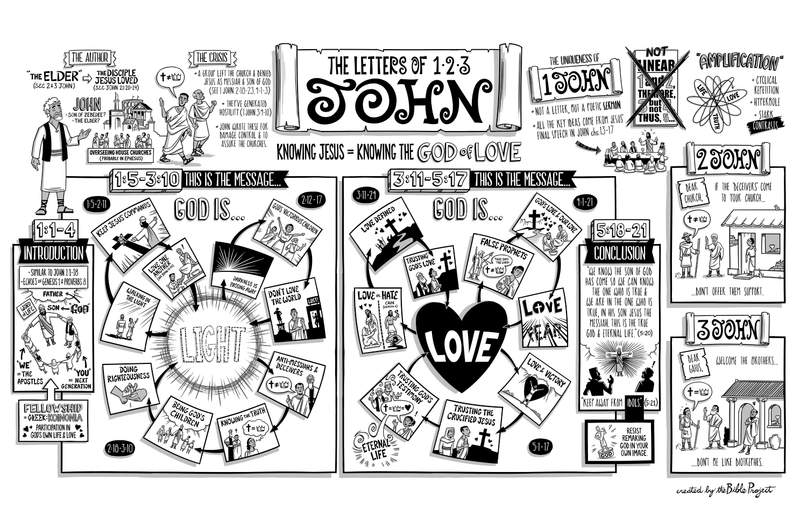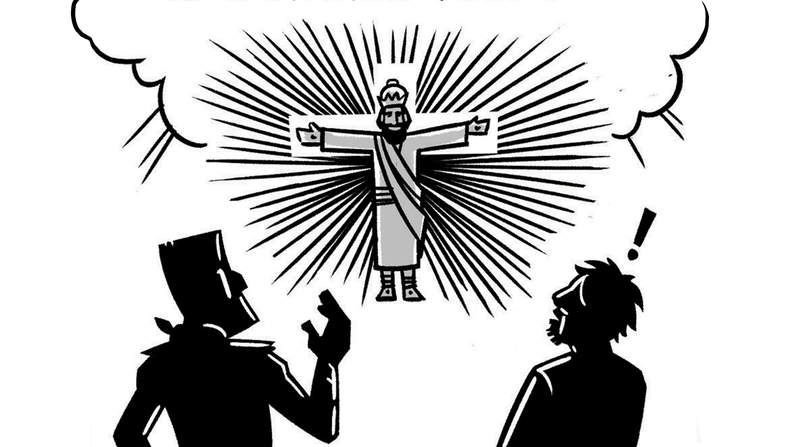The Books of 1-3 John
About

1 John is an anonymous letter, but 2 and 3 John are written by someone called “the Elder.” The language and style of all three letters are identical to each other as well as to John’s Gospel, so most people think that all of them were written by the “disciple whom Jesus loved” (John 21:20-24). This person, however, is yet another enigma. He could be John son of Zebedee and one of the twelve disciples or another John from among Jesus’ early disciples, who was later known as the Elder. Whichever John it is, he is now in his old age and overseeing a network of house church communities, likely around ancient Ephesus.
From clues within the gospel accounts and the letters, it seems that these communities were made up mostly of Jewish followers of Jesus. We also learn that they had recently gone through a crisis, which motivated John to write these letters. He mentions that a group of people have broken off from these churches who no longer acknowledge Jesus as Israel’s Messiah or as God’s Son (1 John 2:18-23; 4:1-3). To make matters worse, they are stirring up hostility among those who stayed behind (1 John 3:4-10).
Who Wrote the Books of 1-3 John?
Context
Key Themes
- God’s light and love
- Righteousness by loving our neighbors
- Jesus as truth
Structure
1 John 1:1-4: The Word of Life
The introduction to this book is very similar to the prologue of the Gospel of John (compare 1 John 1:1-4 with John 1:1-18). It’s packed with echoes of Genesis 1 and Proverbs 8 as John speaks about “the Word of Life” that was with God “in the beginning.” For John, the word “God” refers to both the Father and the Son who came to bring life to the world. Those who saw, heard, and touched the Son are referred to as “we.” In other words, John is talking about himself and the other apostles who were eyewitnesses to Jesus. And now “we” have a message for “you,” the next generation. When the apostolic eyewitnesses share the “Word of Life” with others, they too are brought into fellowship with the Father, the Son, and the apostles. The word for this in Greek is “koinonia,” which means participation or sharing. When people hear the genuine message about Jesus from the eyewitness apostles, the message brings them into a real relationship with the savior himself, as well as into a real participation in God’s life and love.

1 John 1:5-3:10: Walking in the Light of Jesus
This thought flows right into the first main section (1 John 1:5-3:10). The message of the apostles is that the God revealed in Jesus is light. So if they participate in God’s life through Jesus, then they need to keep “walking in the light,” meaning that they must keep Jesus’ commands. When they fail in this, his atoning death covers their sins for them, and they are called again to obey his teachings. John reminds them of the command that Jesus gave his disciples at the last supper, to love one another as he loved them (John 13:34). Doing this is like walking in the light.
If God’s light is now shining through Jesus, then that means the world’s darkness is passing away and God’s children already have victory over the sin and death that reigns in the world. This leads John to give a challenge to the churches. Don’t love the world; it too will pass away. John specifically refers to pride and sexual corruption, which were likely problems connected to the conflict that has recently happened in the churches.
John also takes time to warn these churches about the people who have left and who are denying Jesus as the Messiah (1 John 2:18-3:10). He calls them “anti-Messiahs” and “deceivers.” He’s confident, however, in those who still know the truth about Jesus. These are truly the children of God, who are loved by the Father and who show that they’re a part of God’s family by doing righteousness and loving each other. This is very unlike the deceivers, who are trying to generate anger and strife.
1 John 3:11-5:17: God Is Love
This flows into the second main section of the sermon (1 John 3:11-5:17). Once again, John begins by saying “this is the message” from the apostles, that God is love. His children, therefore, should love each other and avoid hate. They are not to become like Cain from Genesis 4, whose hatred led him to murder his own brother. For Christians, love is defined by Jesus giving up his life as a sacrifice for the well-being of others. When God’s children trust in the love for them that was shown through Jesus, it changes their hearts and minds.
John warns them again about the deceivers, this time calling them “false prophets” (1 John 4:1-21). When these people denied that Jesus is the Messiah, they also claimed to speak for God. But John says to “test the spirits.” If anyone claims to speak for God but doesn’t focus on Jesus, they really don’t speak for him. God’s true children center their lives around the crucified Jesus because that’s where we see God’s heart. On the cross, God is revealed as a being of total self-giving love, compelling us to love others in the same way. When you meet this God of love, it does away with fear and angst for good.
This is a part of what John means by having victory over the world (1 John 5:1-17). When you see the unfathomable depth of God’s love for you, his love becomes the thing that grounds your whole life. This love is what comes through trusting in the crucified Jesus and trusting in God’s testimony, which is given by both the Spirit and the apostles. When God’s love gets a hold of you, it opens up eternal life. This is a way of existing in the world, a way of life that is permeated with God’s life and love, beginning now and carrying on into eternity.
1 John 5:18-21: God and Jesus as One
Now we have the climactic conclusion of the sermon: “We know the Son of God has come so we can know the One who is true. And we are in the One who is true, in his Son Jesus the Messiah. This is the true God, and eternal life” (1 John 5:18-21)
Your head might be spinning, and you may be wondering, “Wait, who is the One who is true and gives me true life? Jesus or God?” And John’s answer is simply, “yes.” John doesn’t know any God apart from Jesus. When he and the other apostles encountered Jesus, they discovered the God who loves us so deeply that he has chosen not to exist without us despite our failures. This revelation of God is so surprising and unexpected that John’s final words call us to “keep away from idols,” that is, to resist any temptation to remake this God in our own image (1 John 5:21). To know Jesus is to know the God of creative life-giving and self-giving love.
2 and 3 John: A Warning for Those Denying Jesus
The second and third letters clearly address the conflict between followers of Jesus and those denying he is the resurrected Messiah and King. 2 John is a warning to a specific house church. The people who deny Jesus, whom John calls the “deceivers,” are probably going to come looking for validation or support. John specifically tells the church that they are not to offer any.

3 John is written to a certain member of a house church named Gaius. John asks Gaius to welcome the legitimate missionaries that will be arriving soon because the leader of that church community, Diotrephes, is acting like a jerk and rejecting people that are associated with John the Elder.
These letters give us a window into the tension and conflict that John faced within these churches. This helps us see 1 John as a form of literary damage control. In it, the Elder assures those who still believe in the Messiah that God is with them as they adhere to the truth. And this context helps us better understand the uniqueness of 1 John, which is not actually a letter at all. The book reads more like a poetic sermon. John says that he’s not communicating new information (1 John 2:9). In fact, almost all of the key words and images in the sermon come right from Jesus’ teachings in John 13-17. John’s goal is to remind and persuade these Christians to stay true to what they already believe.
The poetic quality to John’s sermon is important to note, as he doesn’t develop his ideas in a linear or logical way. Rather, he uses a well-known technique of ancient rhetoric called amplification. John has just a few core ideas to communicate about life, truth, and love, and he cycles through the ideas repeatedly. Each time he offers a slightly different angle and emphasis, using hyperbole and stark contrasts with simple universal images. But don’t let the sermon’s simplicity fool you. This work is deeply profound.
Apart from the clear introduction and conclusion, the flowing cycles of the sermon don’t offer a rigid literary design. That being said, there do seem to be two larger sections (1 John 1:5-3:10 and 3:11-5:17). Both of these are marked off by the introductory phrase “this is the message,” followed by a concentration of images of God as light and love.